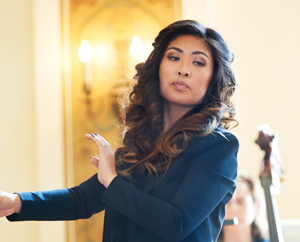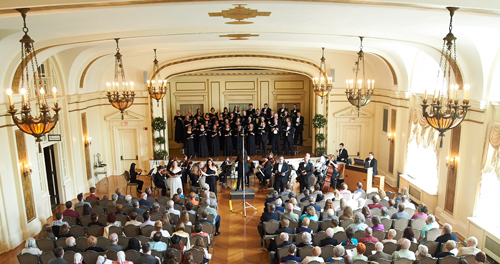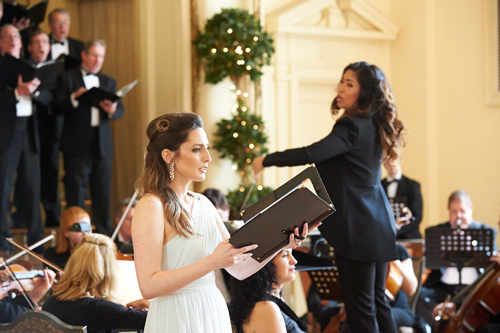by Daniel Hathaway

Asked in a telephone conversation about her plans for her first season, Bucoy-Calavan told us, “Now that I’m the artistic director I want to concurrently honor the tradition that the Summit Choral Society has fostered — providing fantastic music to the community at large — and build a sense of growth and continuity for the organization. Our big theme for the year is ‘conserving, preserving and legacy.’ We want to build on our 25 year history as well as preserving choral and orchestral masterworks for the next generations, ensuring that the arts will live and thrive in the millenial generation as well as in the generation that has already been supporting choral music.”
In addition to her programming strategy, Bucoy-Calavan and Summit Choral Society have established a program that will involve college students or recent graduates (she also serves as director of choral activities at the University of Akron). “They’ll work with me and the members of the Chorale as choral scholars. We’ve also established a choral conducting fellow at the University of Akron who will serve as assistant conductor and learn how to stand in front of a collegiate chorus as well as in front of a community chorus — a very viable job for the future.”
Bucoy-Calavan will begin the season with two masterworks from the choral canon, but will try to reach out to new audiences in a Spring program called Dance With Me. “We’ll be incorporating choral dances like the Brahms “Liebeslieder” Waltzes, but at the same time, engaging professional ballroom dancers and couples to dance while we sing,” she said. “I’m very big on multimedia — bringing two different types of arts together. And I used to be a competitive ballroom dancer myself. This will be a new way for audiences to receive the music as well as to gain new audiences across the arts. Those who sing might be interested in dancing, and dancers may find a new interest in choral music.”
That program will take place in April at the Tangier in Akron. In between, the Summit Choral Society forces will continue their popular Candlelight Christmas Concerts at St. Bernard’s in downtown Akron. “The concerts will be at the same place, but they might have a new flavor,” she said.
How have her singers reacted to the first change in leadership since Summit Choral Society was founded? “Everyone seems to be so welcoming and so enthusiastic. I like to talk about my ‘roots and wings concept’ with my students. You stay rooted in tradition but also allow room for growth and for exploration. They seem very open to trying new things, and growing to become an ensemble they’ve never been before.”

Bucoy-Calavan and the Masterworks Chorale at Greystone last April.
Are millenials taking to choral music these days? “Absolutely!” she said. “By the book, I’m part of that millenial generation myself. I think that’s really interesting and engaging for the students, because my being younger allows for more empathetic music-making. Also I think they see that choral music is relevant in their lives. I think that being 29 and female — a non-traditional conductor, so to speak — tells the community that millenials are still very much enjoying the arts and choral music. I’m very encouraged because so many people still want to be involved. At the University, the concert choir has quadrupled. It used to number 22 and now it’s 85. That includes both music majors and non-music majors. The chamber choir is almost 50% non-music majors.”
Bucoy-Calavan finds it encouraging that while the number of music majors is increasing, there are many non-music majors who still find value in the arts. “They just need to be invited to do so. As a younger person, I don’t just like popular music. I understand the hard work ethic that classical music and choral music entails, so I hope that stands as an example to younger generations.”
The conductor got into choral music through “a circuitous path.” She began as an instrumentalist, first playing flute, then percussion, then French horn. “I ended up singing in a choir and realizing just how difficult it was for an instrumentalist to turn into a vocalist of the quality I wanted to be. You can’t just press a button. You have to have a good set of ears, and kind of a reckless abandon to try anything to get your voice into shape. I fell in love with the amount of ‘loved labor’ it takes to be a fine choral musician. I tried to be active in both vocal and instrumental worlds, but finally I got pulled over into choral music because of the work ethic it took to sing in a choir. I guess my background in both worlds left me with a soft spot for choral and orchestral masterworks — and maybe also a special empathy for percussionists. And how did I become a conductor? The stars just lined up in the right place, and I had mentors and teachers who encouraged me to follow that path.”

As a companion piece to the Requiem, Bucoy-Calavan chose Brahms’s Schiksalslied or Song of Destiny. “The Chorale didn’t really know it, and it’s a favorite of mine. I think it goes well with the legend that it was fate or destiny that led Mozart to write the Requiem. It makes an interesting pairing. I love the ambiguity of the way it ends, and Brahms masterfully uses musical form and keys to set the Hölderin text.”
The orchestra for the occasion will draw on Akron Symphony players, and Bucoy-Calavan has invited a mix of local and imported singers for the solo quartet. “ I want one soloist for every performance to be a young artist. In this field, no one will give you experience unless you already have experience. So the soprano will be Kathryn Papa, a recent Mannes School of Music graduate.” The mezzo will be Chelsea Lyons, a first year master’s degree candidate from Northwestern. Cleveland tenor Corey Showell and University of Akron faculty member Frank Ward Jr. will fill out the quartet.
What does Marie Bucoy-Calavan do when she’s not conducting? As a sort of busman’s holiday, she likes to sing with her husband in the Cleveland Orchestra Chorus under Robert Porco (she previously served as his assistant with the May Festival Chorus in Cincinnati). “I’ve had too many conflicts to do that this fall, but I will be singing Messiah with the chamber choir in December. And my Chamber Choir from the University has been invited to sing with The Cleveland Orchestra in the Severance Hall Christmas Concert on December 12.”
Published on ClevelandClassical.com October 30, 2015.
Click here for a printable copy of this article



